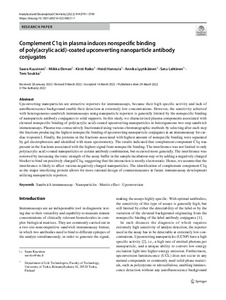Complement C1q in plasma induces nonspecific binding of poly(acrylic acid)-coated upconverting nanoparticle antibody conjugates
Lyytikäinen Annika; Hannula Heidi; Raiko Kirsti; Lahtinen Satu; Ekman Miikka; Soukka Tero; Kuusinen Saara
Complement C1q in plasma induces nonspecific binding of poly(acrylic acid)-coated upconverting nanoparticle antibody conjugates
Lyytikäinen Annika
Hannula Heidi
Raiko Kirsti
Lahtinen Satu
Ekman Miikka
Soukka Tero
Kuusinen Saara
SPRINGER HEIDELBERG
Julkaisun pysyvä osoite on:
https://urn.fi/URN:NBN:fi-fe2022081153686
https://urn.fi/URN:NBN:fi-fe2022081153686
Tiivistelmä
Upconverting nanoparticles are attractive reporters for immunoassays, because their high specific activity and lack of autofluorescence background enable their detection at extremely low concentrations. However, the sensitivity achieved with heterogeneous sandwich immunoassays using nanoparticle reporters is generally limited by the nonspecific binding of nanoparticle antibody conjugates to solid supports. In this study, we characterized plasma components associated with elevated nonspecific binding of poly(acrylic acid)-coated upconverting nanoparticles in heterogeneous two-step sandwich immunoassays. Plasma was consecutively fractionated using various chromatographic methods by selecting after each step the fractions producing the highest nonspecific binding of upconverting nanoparticle conjugates in an immunoassay for cardiac troponin I. Finally, the proteins in the fractions associated with highest amount of nonspecific binding were separated by gel electrophoresis and identified with mass spectrometry. The results indicated that complement component C1q was present in the fractions associated with the highest signal from nonspecific binding. The interference was not limited to only poly(acrylic acid)-coated nanoparticles or certain antibody combination, but occurred more generally. The interference was removed by increasing the ionic strength of the assay buffer in the sample incubation step or by adding a negatively charged blocker to bind on positively charged C1q, suggesting that the interaction is mostly electrostatic. Hence, we assume that the interference is likely to affect various negatively charged nanoparticles. The identification of complement component C1q as the major interfering protein allows for more rational design of countermeasures in future immunoassay development utilizing nanoparticle reporters.
Kokoelmat
- Rinnakkaistallenteet [19207]
